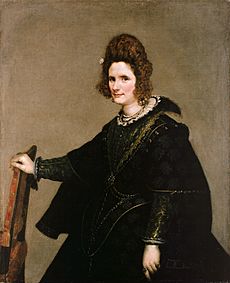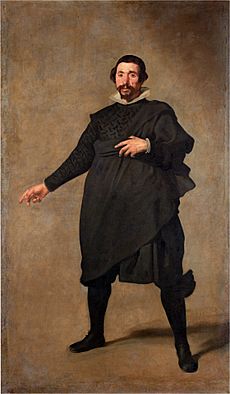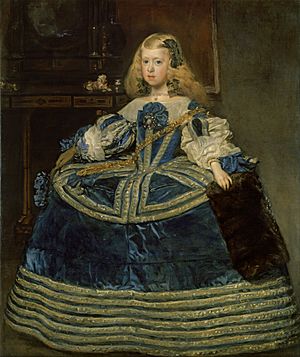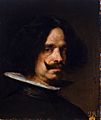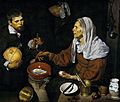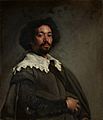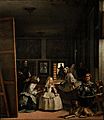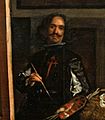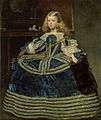Diego Velázquez facts for kids
Quick facts for kids
Diego Velázquez
|
|
|---|---|
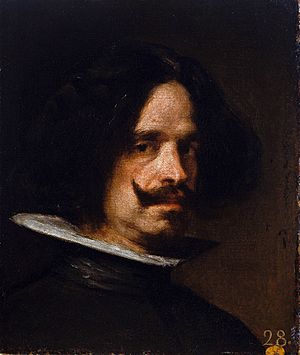
Self-portrait, c. 1640
|
|
| Born |
Diego Rodríguez de Silva y Velázquez
|
| Died | August 6, 1660 (aged 61) Madrid, Spain
|
| Known for | Painting |
|
Notable work
|
The Surrender of Breda (1634–35) Rokeby Venus (1647–51) Portrait of Innocent X (1650) Las Meninas (1656) Las Hilanderas (c. 1657) List of works |
| Movement | Baroque |
Diego Rodríguez de Silva y Velázquez (baptized June 6, 1599 – August 6, 1660) was a famous Spanish painter. He was the main artist for King Philip IV of Spain. Velázquez was a very unique artist during the Baroque period, which was from about 1600 to 1750. This was a time when art, music, and architecture were very grand and dramatic.
He started painting in a detailed, dark style called tenebrism. Later, his style became much freer, using bold brushstrokes. Velázquez painted many important historical and cultural scenes. He also created many portraits of the Spanish royal family and everyday people. His most famous painting is Las Meninas (1656).
Velázquez's paintings became a guide for artists in the 1800s. These artists focused on realism (showing things as they really are) and impressionism (capturing a moment or feeling). In the 1900s, famous artists like Pablo Picasso, Salvador Dalí, and Francis Bacon honored Velázquez. They re-imagined some of his most well-known paintings in their own styles.
Most of his artwork became part of the Spanish royal collection. The best collection of his paintings is at the Museo del Prado in Madrid. Some of his portraits were sent to other countries as gifts, especially to the Austrian Habsburgs royal family.
Contents
Early Life and Training
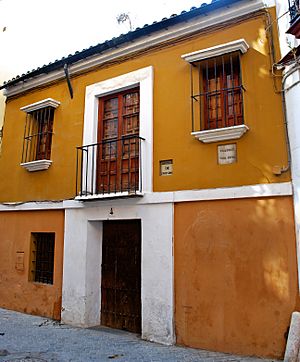
Velázquez was born in Seville, Spain. He was the first child of Juan Rodríguez de Silva, who was a notary (someone who officially witnesses signatures). His mother was Jerónima Velázquez. He was baptized on June 6, 1599, at the church of St. Peter in Seville. This likely happened a few days or weeks after his birth.
Velázquez showed a talent for art early on. He became an apprentice to Francisco Pacheco, an artist and teacher in Seville. An old biographer, Antonio Palomino, said Velázquez might have studied briefly with Francisco de Herrera. However, this is not fully proven. A contract from 1611 shows he had a six-year apprenticeship with Pacheco.
Pacheco was not considered a great painter himself. But he was very learned and encouraged his students to think deeply. In Pacheco's school, Velázquez studied classic art and learned about proportion and perspective. He also saw the latest trends in art and literature in Seville.

On April 23, 1618, Velázquez married Juana Pacheco. She was his teacher's daughter. They had two daughters. Their older daughter, Francisca, married painter Juan Bautista Martínez del Mazo in 1633. Their younger daughter, Ignacia, died when she was a baby.
Velázquez's first paintings were bodegones. These were kitchen scenes that often featured still-life objects. He was one of the first Spanish artists to paint such scenes. His painting Old Woman Frying Eggs (1618) shows his amazing skill at painting realistic details. The strong realism and dramatic lighting in this work might have been inspired by Caravaggio's art.
Some of his bodegones like Kitchen Scene with Christ in the House of Martha (1618) included religious scenes in the background. This made it unclear if the religious scene was a painting on the wall, a thought in the maid's mind, or something happening outside a window. His religious works also include The Adoration of the Magi (1619). These works started to show his very precise and careful realism.
Another important work from this time is The Water Seller of Seville (1618–1622). This painting is praised for how well it shows shapes and textures. It also has a serious and mysterious feeling.
Moving to Madrid: Becoming a Royal Painter
By the early 1620s, Velázquez was well-known in Seville. He traveled to Madrid in April 1622. He had letters of introduction to important people, including Don Juan de Fonseca, who was the King's chaplain. Velázquez was not allowed to paint the new king, Philip IV, at first. Instead, he painted the poet Luis de Góngora.
In December 1622, the king's favorite court painter died. Velázquez was then asked to come to the court by Gaspar de Guzmán, Count-Duke of Olivares. Olivares was a powerful minister to Philip IV. Velázquez was given money for his travel and stayed at Fonseca's home. He painted a portrait of Fonseca, which was sent to the royal palace.
On August 30, 1623, King Philip IV sat for Velázquez. The King liked the portrait very much. Olivares then told Velázquez to move to Madrid. He promised that no other painter would ever paint Philip's portrait. Velázquez received money from the king to move his family to Madrid in 1624. Madrid became his home for the rest of his life.
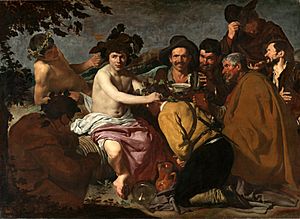
Velázquez joined the royal service. He received a monthly salary, a place to live, and payment for his paintings. His portrait of Philip was shown publicly and was very popular. The Museo del Prado has two of Velázquez's portraits of the king. In these, his earlier serious style has softened, and the colors are more delicate.
In 1627, Philip held a painting competition. The subject was the expulsion of the Moors from Spain. Velázquez won the competition. As a reward, he was made a gentleman usher. He also received a daily allowance and money for clothes.
In September 1628, the famous painter Peter Paul Rubens visited Madrid. Velázquez went with him to see the Titian paintings at the Escorial. Rubens thought highly of Velázquez. He also made Velázquez want to visit Italy to see the works of the great Italian masters.
In 1629, Velázquez painted The Triumph of Bacchus, also called Los Borrachos (The Drunks). This painting shows a group of men in everyday clothes honoring a young man crowned with ivy. This was Velázquez's first painting of a mythological scene. It shows the natural style of his early works, with some influence from Titian and Rubens.
First Trip to Italy
In 1629, Velázquez was allowed to spend a year and a half in Italy. This first visit was very important for his painting style. King Philip IV even paid for his trip. We don't know all the details of what he saw or who he met.
He traveled to many cities, including Venice, Rome, and Naples. In Naples, he probably met the painter Ribera. The main paintings from his first Italian trip are Joseph's Bloody Coat brought to Jacob (1629–30) and Apollo in the Forge of Vulcan (1630). These paintings show his desire to be as good as the Italian history painters.
In these works, Velázquez showed his characters as ordinary people. Their gestures and expressions were like those in everyday life. He also started using a light gray background for his canvases. This made his paintings brighter and more luminous than before. He continued to use light gray backgrounds for the rest of his career.
Return to Madrid: Middle Period

Velázquez returned to Madrid in January 1631. That year, he painted the first of many portraits of the young prince, Balthasar Charles. In paintings like Equestrian portrait of prince Balthasar Charles (1635), Velázquez showed the prince looking noble and dignified.
Velázquez also painted equestrian (on horseback) portraits of the royal family for the king's new palace, the Palacio del Buen Retiro. In Philip IV on Horseback (1634–35), the king looks calm and majestic. He shows great skill at riding.
The large painting The Surrender of Breda (1634–35) was also for the palace. It is Velázquez's only surviving painting of a recent historical event. It shows a Spanish military victory over the Dutch. But instead of showing conquest, Velázquez shows the Spanish general standing as an equal to his Dutch opponent. He even offers a hand of comfort. This makes the scene very unique and respectful.
Velázquez painted many portraits of the powerful minister Olivares. In The Count-Duke of Olivares on Horseback (c. 1635), Olivares is shown flatteringly as a military leader. These portraits show Velázquez's gratitude to Olivares, who first brought him to the king's attention.
The sculptor Juan Martínez Montañés created a statue based on one of Velázquez's equestrian portraits of the king. This bronze statue now stands in the Plaza de Oriente in Madrid. Velázquez was often with King Philip. He even went with him to Aragon in 1644. There, he painted a portrait of the king in his military uniform.
Velázquez's paintings of Aesop and Menippus (both c. 1636–1638) show ancient writers. But they look like portraits of beggars. Mars Resting (c. 1638) shows the mythological god Mars. Yet, he looks like a tired, middle-aged man. The painting has been seen in different ways. Some think it's about reality and art. Others see it as a sad thought about Spain's declining power.
If it weren't for his royal job, Velázquez might not have been able to paint La Venus del espejo (c. 1644–1648, English: Venus at her Mirror). This is because the Spanish Inquisition (a powerful religious court) might have censored it.
Portraits of the Court
Velázquez painted many portraits of King Philip. He also painted other members of the royal family. These included Philip's first wife, Elisabeth of Bourbon, and their children. He painted their eldest son, Don Baltasar Carlos, from a young age. Many other people from the court, like soldiers and churchmen, also sat for Velázquez.
Velázquez also painted several court jesters and dwarfs. He showed them with kindness and respect for their unique personalities. For example, The Jester Don Diego de Acedo (1644) shows an intelligent face. A large book and ink bottle next to him suggest he was a wise and educated man. Pablo de Valladolid (1635) and The Buffoon of Coria (1639) are also from this time.
As a court painter, Velázquez had fewer requests for religious paintings than other artists. Christ Crucified (1632) was painted for a convent in Madrid. It shows Christ right after death. His head hangs, and dark hair covers part of his face. This emphasizes the idea of death. The figure is alone against a dark background.
Velázquez's son-in-law, Juan Bautista Martínez del Mazo, also became an usher in the royal household. Mazo was promoted steadily. He received money for his portraits and became an inspector of works in the palace.
Philip then asked Velázquez to find paintings and sculptures for the royal collection. Spain had many paintings but few statues. So, Velázquez was sent to Italy again to buy art.
Second Visit to Italy
In 1649, Velázquez set out for Italy. He was joined by his assistant, Juan de Pareja. Pareja was also a painter, trained by Velázquez. They sailed from Málaga and traveled through many Italian cities. Velázquez bought paintings by famous artists like Titian and Tintoretto.
In Modena, he was welcomed by the duke. He painted the duke's portrait there. He also painted two portraits that are now in the Dresden gallery. These works show the beginning of his third and final painting style.
He then went to Rome. There, he painted the famous portrait of Pope Innocent X (1650). The Pope was very pleased with the painting. He gave Velázquez a medal and a golden chain. Velázquez took a copy of the portrait back to Spain. This portrait shows a bold, sharp style. It captures Innocent's expression so strongly that some in the Vatican worried the Pope might not like it. But he did, and he hung it in his waiting room.
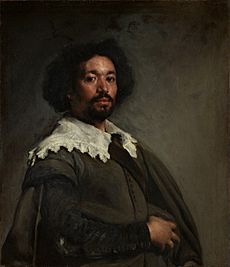
In 1650, in Rome, Velázquez also painted a portrait of Juan de Pareja. This painting is now in the Metropolitan Museum of Art in New York City. This portrait helped him get elected into the Accademia di San Luca, an art academy. Velázquez supposedly painted this portrait to warm up his skills before painting the Pope. It shows Pareja's face and worn clothes in great detail. In November 1650, Velázquez freed Juan de Pareja.
From this time, there are also two small landscape paintings. They are both called View of the Garden of the Villa Medici. These landscapes were likely painted directly from nature, which was unusual for the time. They show Velázquez's careful study of light at different times of day.
Velázquez also ordered twelve bronze copies of the Medici lions for the Room of Mirrors at the Royal Alcazar of Madrid. These copies are now in the Royal Palace of Madrid and the Museo del Prado.
Return to Spain and Later Career
From February 1650, King Philip kept asking Velázquez to return to Spain. So, after visiting Naples and Venice, Velázquez returned to Spain in 1651. He brought many paintings and statues with him for the king's collection.
Queen Elisabeth of France had died in 1644. The king had married Mariana of Austria. Velázquez painted many portraits of her. In 1652, the king chose him for a high position called aposentador mayor. This job meant he had to manage the court's living quarters. It was a big responsibility and took time away from his painting. However, his works from this period are still among his best.
Las Meninas: A Masterpiece

One of the infantas (princesses), Margaret Theresa, is often seen as the main subject of Las Meninas (1656). This painting is Velázquez's greatest work. It was created four years before he died. It is an amazing example of European baroque art.
Some people call it the "theology of painting" or the "philosophy of art." But it's not clear who or what the painting is really about. Is it the princess, or perhaps Velázquez himself? The king and queen are seen reflected in a mirror on the back wall. But where is the reflection coming from? Are they standing where the viewer is, or is the mirror reflecting the painting Velázquez is working on? Some think the faded image of the king and queen hints at the future decline of the Spanish Empire.
The king is said to have painted the honorary Cross of Saint James on Velázquez's chest in the painting. This cross means he was a knight of the Order of Santiago. However, Velázquez did not receive this honor until three years after he finished the painting. Even the King of Spain needed approval for his painter to become a knight. This was because they had to check if the person had a "pure lineage." This meant checking for any Jewish or Moorish ancestry, or if their family had been involved in trade. Velázquez was given the honor in 1659. His job as a painter was accepted because, as the king's painter, he wasn't seen as "selling" pictures.
Final Years and Legacy

In Spain, there were mainly two types of art patrons: the church and the art-loving king and court. While other artists struggled, Velázquez lived comfortably with a good salary and pension from the king.
One of his last works was Las hilanderas (The Spinners), painted around 1657. It shows a story from Ovid about Arachne. This painting is full of light, air, and movement. It has vibrant colors and careful brushwork. It shows all the art knowledge Velázquez had gained over his forty-year career.
Velázquez's final portraits of the royal children are among his best. In the Infanta Margarita Teresa in a Blue Dress, his personal style reached its peak. Shimmering spots of color create an almost impressionistic effect. Viewers need to stand at a distance to see the full, three-dimensional space.
His only surviving portrait of the delicate Prince Felipe Prospero is special. It combines the sweet features of the child and his dog with a subtle sense of sadness. The hope placed in the young heir to the Spanish crown is shown. Fresh red and white colors contrast with darker, autumn colors. A small dog looks at the viewer as if asking a question. The pale background hints at a sad fate, as the little prince died at barely four years old. In all of Velázquez's late paintings, the colors are very fluid and lively.
In 1660, a peace treaty between France and Spain was sealed by the marriage of Maria Theresa to Louis XIV. The ceremony took place on the Island of Pheasants. Velázquez was in charge of decorating the Spanish pavilion and all the scenery. He was noticed for his noble presence and splendid clothes.
He returned to Madrid on June 26 and fell ill with a fever on July 31. Feeling his end was near, he signed his will. He died on August 6, 1660. He was buried in the church of San Juan Bautista. His wife, Juana, was buried next to him eight days later. This church was destroyed around 1809, so his burial place is now unknown.
It was difficult to sort out the money Velázquez was owed by the treasury. It wasn't until 1666, after King Philip died, that everything was finally settled.
Style and Painting Techniques
Velázquez's career is often divided by his two trips to Italy. He rarely signed his paintings. The royal records only give dates for his most important works. We learn about the rest from clues in his portraits and historical information.
Velázquez knew about all the Italian art schools and was friends with leading painters. But he was strong enough to develop his own unique style. He avoided the grand, showy portraits of other European courts. Instead, he used a more reserved style for the Habsburg family portraits. This style was set by artists like Titian and Antonio Mor.
He is known for using a limited range of colors. But he mixed them skillfully to create many different shades. His paints were similar to those used by other artists of his time. He mainly used blue, green, red, yellow, and earth tones. His early works were painted on canvases with a red-brown base. During his first trip to Italy, he started using light gray bases. He continued this for the rest of his life. This change made his paintings brighter and gave them a cool, silvery look.
Few drawings are definitely by Velázquez. He painted directly from life. X-rays of his paintings show that he often changed his compositions as he worked.
Velázquez's Influence on Art
Velázquez was not a very fast painter. It is thought he produced between 110 and 120 known paintings. He did not make any etchings or engravings, and only a few drawings are believed to be his.
Velázquez is the most important figure in Spanish portrait painting. He didn't have many direct students. But Spanish court painters like his son-in-law Juan Bautista Martinez del Mazo were inspired by his work. Mazo copied his style closely. Many paintings by Mazo were once thought to be by Velázquez.
Velázquez's fame faded in the 1700s. At that time, foreign artists dominated Spanish court portraits. But by the end of the century, his importance was recognized again. In 1778, Goya made etchings based on Velázquez's paintings. Goya's copies show how deeply he studied Velázquez's work. Velázquez remained a model for Goya throughout his career.
Velázquez's work was not well known outside of Spain until the 1800s. Most of his paintings were not stolen by the French during the Peninsular War. In 1828, Sir David Wilkie wrote from Madrid that he felt a new power in art when he saw Velázquez's works. He also found a strong connection between Velázquez and British portrait painters. He was impressed by the modern feel of Velázquez's landscapes and portraits.
Velázquez is often seen as a key influence on Édouard Manet. Manet is considered the link between realism and impressionism. Manet called Velázquez the "painter of painters." He admired the directness and lively brushwork in Velázquez's art. Manet also used Velázquez's ideas in his own paintings. In the late 1800s, artists like James McNeill Whistler and John Singer Sargent were also greatly influenced by Velázquez.
Modern Artists Reimagining Velázquez
The respect that 20th-century painters had for Velázquez's work shows its lasting importance. Pablo Picasso honored Velázquez in 1957. He created 44 different versions of Las Meninas in his own unique style. Picasso worried that his new versions might just seem like copies. But these huge works, some of the largest he made since Guernica in 1937, became very important in Spanish art.
Salvador Dalí also created a work in 1958 called Velázquez Painting the Infanta Margarita With the Lights and Shadows of His Own Glory. This was done around the 300th anniversary of Velázquez's death. The colors in Dalí's painting show his serious tribute to Velázquez. Like Picasso's work, Dalí's painting also presented new ideas in art and thought.
The Anglo-Irish painter Francis Bacon thought Velázquez's portrait of Pope Innocent X was "one of the greatest portraits ever." He made several expressionist versions of this painting in the 1950s. However, Bacon's paintings showed a more gruesome image of Innocent. One famous version, Figure with Meat (1954), shows the Pope between two halves of a cut-up cow.
Recent Discoveries of Velázquez Originals
In 2009, a painting called Portrait of a Man at the Metropolitan Museum of Art was cleaned and restored. It had long been thought to be by followers of Velázquez. But it was found to be by Velázquez himself! The man's features match a figure in The Surrender of Breda. So, this new painting might be a study for that famous work. While it's certain that Velázquez painted it, the man's identity is still a question. Some art historians think it might even be a self-portrait of Velázquez.
In 2010, it was reported that a damaged painting at the Yale University Art Gallery might be an early work by Velázquez. This painting, which shows the Virgin Mary being taught to read, was given to Yale in 1925. It was previously thought to be from the 17th-century Spanish school. Some experts believe it is by Velázquez, but the Prado Museum in Madrid is still deciding. The painting will be restored by experts at Yale.
In October 2011, an art historian confirmed that a portrait found in the UK is a previously unknown work by Velázquez. This was confirmed through x-ray analysis. The portrait is of an unidentified man in his fifties or sixties. He might be Juan Mateos, who was the Master of the Hunt for King Philip IV. The painting was sold at auction in December 2011 for £3,000,000.
Velázquez's Descendants
Through his daughter Francisca, Velázquez is an ancestor of several European royal families. These include King Felipe VI of Spain, King Willem-Alexander of the Netherlands, King Carl XVI Gustaf of Sweden, King Albert II of Belgium, Hans-Adam II, Prince of Liechtenstein, and Henri, Grand Duke of Luxembourg.
Popular Culture
Velázquez has been played by Julián Villagrán in a Spanish fantasy TV series called El ministerio del tiempo. Velázquez is a character who appears often in the series.
Images for kids
-
La rendición de Breda (1634–35) was inspired by Velázquez's first visit to Italy, in which he accompanied Ambrogio Spinola, who conquered the Dutch city of Breda a few years prior. It depicts a transfer of the key to the city from the Dutch to the Spanish army during the Siege of Breda. It is considered one of the best of Velázquez's paintings.
See also
 In Spanish: Diego Velázquez para niños
In Spanish: Diego Velázquez para niños



